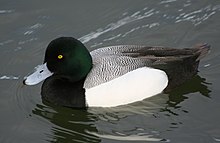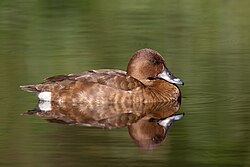Diving duck
| Diving ducks | |
|---|---|

| |
| Greater scaup,Aythya marila | |
| Scientific classification | |
| Domain: | Eukaryota |
| Kingdom: | Animalia |
| Phylum: | Chordata |
| Class: | Aves |
| Order: | Anseriformes |
| Family: | Anatidae |
| Subfamily: | Anatinae |
| Tribe: | Aythyini |
| Genera | |
|
See the text | |
Thediving ducks,commonly calledpochardsorscaups,are a category ofduckwhich feed by diving beneath the surface of the water. They are part ofAnatidae,the diverse and very largefamilythat includes ducks,geese,andswans.
The diving ducks are placed in a distinct tribe in the subfamilyAnatinae,theAythyini.Whilemorphologicallyclose to thedabbling ducks,[1]there are nonetheless some pronounced differences such as in the structure of thetrachea.mtDNAcytochromebandNADH dehydrogenasesubunit2sequencedata indicate that the dabbling and diving ducks are fairly distant from each other, the outward similarities being due toconvergent evolution.[2] Alternatively, the diving ducks are placed as asubfamilyAythyinaein the family Anatidae which would encompass all duck-like birds except thewhistling-ducks.[3][failed verification] Theseaduckscommonly found in coastal areas, such as thelong-tailed duck(formerly known in the U.S. as oldsquaw),scoters,goldeneyes,mergansers,buffleheadandeiders,are also sometimes colloquially referred to in North America as diving ducks because they also feed by diving; their subfamily (Merginae) is a very distinct one however.
Although the group iscosmopolitan,most members are native to theNorthern Hemisphere,and it includes several of the most familiar Northern Hemisphere ducks.
This group of ducks is so named because its members feed mainly by diving, although in fact theNettaspecies are reluctant to dive, and feed more like dabbling ducks.
These are gregarious ducks, mainly found on fresh water or onestuaries,though thegreater scaupbecomes marine during the northern winter. They are strong fliers; their broad, blunt-tipped wings require faster wing-beats than those of many ducks and they take off with some difficulty. Northern species tend to bemigratory;southern species do not migrate though thehardheadtravels long distances on an irregular basis in response to rainfall. Diving ducks do not walk as well on land as thedabbling ducks;their legs tend to be placed further back on their bodies to help propel them when underwater.
Systematics
[edit]Threegeneraare included in the Aythyini. Themarbled duckwhich makes up themonotypicgenusMarmaronetta,however, seems very distinct and might have diverged prior to the split of dabbling and diving ducks as indicated by morphological and molecular characteristics.[1][2]The probably extinctpink-headed duck,previously treated separately inRhodonessa,has been suggested to belong intoNetta,[1][4]but this approach has been questioned.[5]DNA sequenceanalyses have found it to be the earliest diverging member of the pochard group.[6]The molecular analysis also suggests that thewhite-winged duckshould be placed into amonotypicgenusAsarcorniswhich is fairly close toAythyaand might belong into this subfamily.[2]

Family Anatidae
[edit]- Subfamily Anatinae
- Tribe Aythyini
- GenusRhodonessa
- Pink-headed duck(Rhodonessa caryophyllacea); probablyextinct(1945?)
- GenusMarmaronetta
- Marbled duck(Marmaronetta angustirostris)
- GenusNetta(provisionally includingRhodonessa)
- Red-crested pochard(Netta rufina)
- Southern pochard(Netta erythrophthalma)
- Rosy-billed pochard(Netta peposaca)
- GenusAythya
- Canvasback(Aythya valisineria)
- Common pochard(Aythya ferina)
- Redhead(Aythya americana)
- Ring-necked duck(Aythya collaris)
- Hardhead(Aythya australis)
- Baer's pochard(Aythya baeri)
- Ferruginous duck(Aythya nyroca)
- Madagascar pochard(Aythya innotata) – feared to be extinct, rediscovered (2006)
- Réunion pochard, (Aythyacf.innotata) – extinct (c. 1690s)
- New Zealand scaup(Aythya novaeseelandiae)
- Tufted duck(Aythya fuligula)
- Greater scaup(Aythya marila)
- Lesser scaup(Aythya affinis)
- GenusRhodonessa
- Tribe Aythyini
References
[edit]- ^abcLivezey, Brad C. (1986)."A phylogenetic analysis of recent anseriform genera using morphological characters"(PDF).The Auk.116(3): 792–805.Retrieved22 July2010.
- ^abcJohnson, Kevin P.,Sorenson, Michael D., Kevin P.; Sorenson, Michael D. (1999)."Phylogeny and biogeography of dabbling ducks (genus Anas): a comparison of molecular and morphological evidence"(PDF).The Auk.116(3): 792–805.doi:10.2307/4089339.JSTOR4089339.Retrieved22 July2010.
{{cite journal}}:CS1 maint: multiple names: authors list (link) - ^Terres, John K. (1991).TheAudubon SocietyEncyclopedia of North American Birds.Wings Books.ISBN0-517-03288-0.
- ^Livezey, Brad C. (1998)."A phylogenetic analysis of modern pochards (Anatidae: Aythyini)"(PDF).The Auk.113(1): 74–93.doi:10.2307/4088937.JSTOR4088937.Retrieved22 July2010.
- ^Nigel J. Collar, ed. (2004).Threatened Birds of Asia: The BirdLife International Red Data Book.BirdLife International.ISBN0-946888-44-2.
- ^Ericson, Per G. P.; Qu, Yanhua; Blom, Mozes P. K.; Johansson, Ulf S.; Irestedt, Martin (December 2017)."A genomic perspective of the pink-headed duck Rhodonessa caryophyllacea suggests a long history of low effective population size".Scientific Reports.7(1): 16853.doi:10.1038/s41598-017-16975-1.ISSN2045-2322.PMC5715134.PMID29203781.
